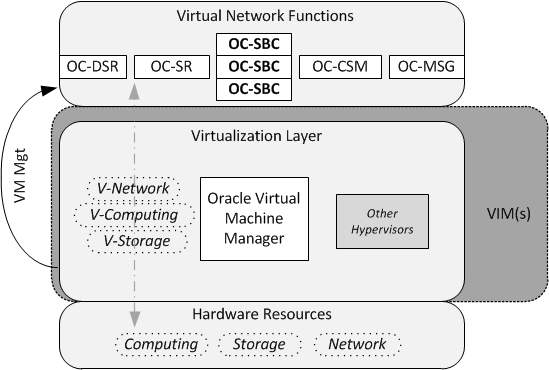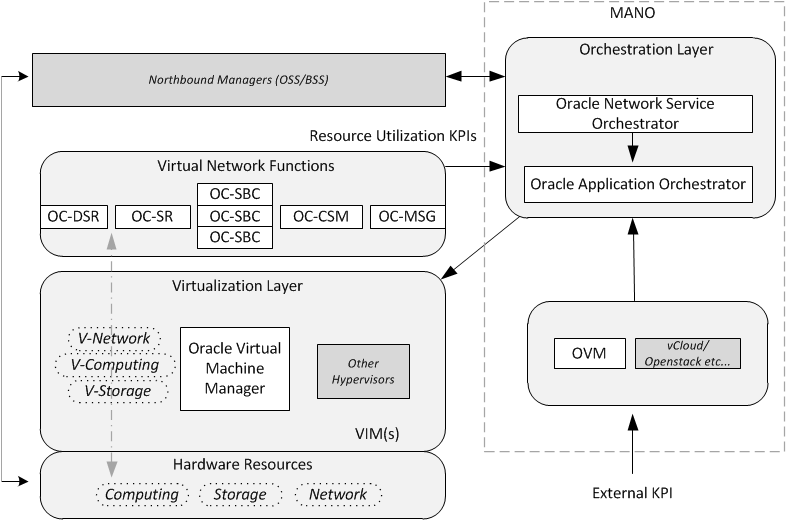Network Functions Virtualization Overview
Network Functions Virtualization (NFV) is a set of architectural standards to leverage enterprise and cloud technologies for virtualization and lifecycle resource automation in telecommunications core networks. It is focused on identifying the use cases and needs of communications service providers for automated, virtualized infrastructure and network functions, along with an architecture to frame discussions on meeting those needs, and an analysis of the gaps with existing technologies. Standards defining the NFV architecture addressed in this document include "ETSI GS NFV 002 Architectural Framework", ETSI GS NFV 004 "Virtualization Requirements" and related. Oracle can provide its OCSBC and OCSR, as well as other network systems, as Virtual Network Functions (VNFs) or Management Systems for operation within an NFV-enabled environment.
One of the main drivers for NFV is capital equipment cost reduction for CSPs. Virtual functions running on fewer COTS servers is much cheaper than using multiple purpose built appliances. NFV meets the needs for cost reduction in addition to allowing the CSP to turn up new services and capacity more rapidly.
It is generally recognized now that operators desire to move their core network functions into automated and virtualized environments based on these technologies, starting with large operators in North America, Europe, and Asia. To accomplish this requires changes in the infrastructure that hosts the network functions, changes in the network functions, and additions to the management and automation of the life cycle of network services.
In the NFV Industry Specification Group under ETSI, which is where the bulk of industry focus on defining the use cases and architecture for NFV have been, an architectural framework, shown below, has been defined that is the basis for most discussions of the various functional components needed for an NFV environment. These components are divided into the Hardware, the VNFs and the virtualization layer. Commodity hardware provides the physical components for computing, and are the same as those without virtualization. The virtualization layer provides the means through which virtual machines can operate. The VNFs are the virtual machines themselves, instantiated as Virtual Network Functions (VNFs). These components establish a VNF deployment that can be fully operational, but without orchestration.

Extending upon these basic operational components are the Management and Orchestration components (MANO) components. MANO provides a means by which operators approach a zero-touch orchestration, operation and management deployment. The resulting automated, elastic construct more fully addresses the OPEX efficiencies and real-time responsiveness desired from NFV.
To complete the NFV picture, MANO components are included in the diagram below, consisting of the orchestration layer and VIM components associated with managing your NFV. This diagram also adds the northbound OSS/BSS systems. The orchestration layer supports NFV instantiating and de-commissioning based on operational requirements and status, as well as on business requirements and preferences. The MANO model also provides for basic FCAPS management, encapsulating those management functions outside of orchestration.

Network operators establish criteria for automated VNF instantiation within the orchestration layer, by configuring the overall system to use external and internal status within KPIs to define the triggers for changes to VNF resources. VNFs themselves provide critical status information that, when combined with organizational policy and other status triggers, the MANO uses to adjust network resources to network requirements in real time.
Oracle's NFV solution harnesses the extensive assets from its portfolio to deliver a vision of a network orchestration being driven by a business orchestration, which in turn delivers business value to the customer. This vision builds on the investment that Oracle Communications has made in the BSS/OSS domain to deliver a BSS/OSS that is orchestrated along business processes. The Oracle Communication Network Service Orchestrator provides the join of the two worlds by bridging the chiasm between Network Orchestration and Business Orchestration.
Oracle's NFV solution builds on the investment Oracle has made in the network domain to have an extensive portfolio of Network Functions as well as network orchestration.



